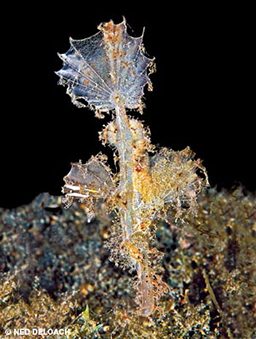Anna and I have been hunting ghosts for more than a decade now. Unlike fantasies of fear and superstition, our three-inch underwater phantoms are real, but they are every bit as illusive and ephemeral as ghosts of imagination.

When we first traveled to the Asian Pacific, the specters we were chasing, ghostpipefishes, ranked high on our must-see list of celebrity animals. The trick was finding them. During early visits, the fabled family of five species disguised as leaves, seagrass stems and crinoid arms escaped our untrained eyes. But as we became familiar with their nature, the ghosts began to appear, and they were even more majestic than we imagined.
Ghostpipefishes are not only hard to find, they are also rare, spending most of their short lives in the open ocean as bits of plankton before eventually settling in protected coastlines, where they discreetly blend into the shadows and breed. If there is such a thing as a ghostpipefish settling season, our party arrives in Dumaguete, in the Philippines, at its peak. Instead of finding one or two ghosts as would be expected, reports of multiple sightings keep coming in. One morning Anna tallies 11 on a single dive. Everyone is thrilled; it’s animals like these we travel halfway around the world to see.
The next day Anna and I head down a coastal slope to a patch of nautical trash where a pair of ornate ghostpipefish — the family’s most iconic member — had been spotted the previous day. We find the fish hiding in a tangle of spiked crinoid arms that matches the pair’s spiny skin and color scheme to a T. When ornates, like other ghostpipefishes, arrive from the open sea they are all wispy males that immediately set about finding partners. After a bond has been established between two males, one of them begins to transform into a female, triggering a growth spurt in which the new female quickly outpaces her partner in size. As the female matures, her fan-shaped ventral fins enlarge into a hinged brooding pouch, which will soon hold up to 300 eggs in various stages of development. Once established, pairs of ornates not only tend to stay together but also to stay put, feeding on an endless supply of zooplankton that drifts their way.

The two other family members we find off Dumaguete, robust and roughsnout ghostpipefishes, live a more transient life, plucking tiny crustaceans off the seafloor. Their compulsory travels to procure food force the species to adapt their camouflage and behavior to match any number of complex habitats. In the shallows, we follow a chocolate-brown pair of robusts riding the surge with a fallen leaf. When the leaf tumbles, the pair tumbles; when the leaf rockets away, the ghosts follow suit, looking like blowing debris. In the afternoon a mated pair of robusts living in the seagrass offers a striking example of how adaptation can take different twists. The female mimics the living grass blades and their forest of epiphytes with a green coat and brown tassels. Her emerald wardrobe contrasts sharply with her companion’s unadorned patchwork of earth tones that resembles decaying stems.
Although it is clear how skillfully ghostpipefishes mimic their surroundings, no one is certain if they can alter existing camouflage to duplicate a new environment. On one dive we follow an obviously out-of-place green roughsnout across a stretch of bare sand for a quarter hour without noting any change. If transformations occur, they must be slow, taking place over days or weeks.
As we’re beginning to think ghost hunting can’t get any better, it does. While sorting through a bed of algae, I experience a can’t-quite-believe-my-eyes moment common to critter hunters. I blink, squint and blink again, and lo and behold the most outrageous ghostpipefish I’ve ever encountered turns out to be real — a big, beautiful female roughsnout dripping with filaments. I note the spot and dash off to find Anna. Minutes later we’re back staring intently into the algae. When Anna’s eyes finally fix on the little illusionist’s broken profile, she gives a squeal — exactly what anyone would do, having just seen a ghost.
Explore More
© Alert Diver — Q3 Summer 2011